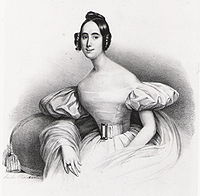
Mademoiselle Ambroisine
Encyclopedia

France
The French Republic , The French Republic , The French Republic , (commonly known as France , is a unitary semi-presidential republic in Western Europe with several overseas territories and islands located on other continents and in the Indian, Pacific, and Atlantic oceans. Metropolitan France...
actress and ballet dancer. She was considered the leading lady of romantic ballet
Romantic ballet
The Romantic ballet is defined primarily by an era in ballet in which the ideas of Romanticism in art and literature influenced the creation of ballets. The era occurred during the early to mid 19th century primarily at the Théâtre de l'Académie Royale de Musique of the Paris Opera Ballet and Her...
in Brussels
Brussels
Brussels , officially the Brussels Region or Brussels-Capital Region , is the capital of Belgium and the de facto capital of the European Union...
during the 1832 to 1836.
Ambroisine's career on the stage began at the Théâtre de l'Ambigu-Comique
Théâtre de l'Ambigu-Comique
The theatre was rebuilt to plans by the architects Jacques Ignace Hittorff and Jean-François-Joseph Lecointe on the boulevard Saint-Martin, at the corner of rue de Bondy...
in Paris
Paris
Paris is the capital and largest city in France, situated on the river Seine, in northern France, at the heart of the Île-de-France region...
where she acted, playing children, from the age of eight. From the age of ten she attended the dance school at the Théâtre de la Porte Saint-Martin
Théâtre de la Porte Saint-Martin
The Théâtre de la Porte Saint-Martin is a venerable theatre and opera house at 18, Boulevard Saint-Martin in the 10e arrondissement of Paris.- History :...
, whose ballet productions were considered superior to those of the Opéra National de Paris at that time.
She advanced from minor roles to premiere danseuse
Ballerina
A ballerina is a title used to describe a principal female professional ballet dancer in a large company; the male equivalent to this title is danseur or ballerino...
at the ballet in Lyon
Lyon
Lyon , is a city in east-central France in the Rhône-Alpes region, situated between Paris and Marseille. Lyon is located at from Paris, from Marseille, from Geneva, from Turin, and from Barcelona. The residents of the city are called Lyonnais....
in 1830. There she met tenor
Tenor
The tenor is a type of male singing voice and is the highest male voice within the modal register. The typical tenor voice lies between C3, the C one octave below middle C, to the A above middle C in choral music, and up to high C in solo work. The low extreme for tenors is roughly B2...
Claude Sirand, whom she was to marry on 5 February 1836, in Brussels. Her first appearance in Brussels was on 14 October 1832 at La Monnaie
La Monnaie
Le Théâtre Royal de la Monnaie , or the Koninklijke Muntschouwburg is a theatre in Brussels, Belgium....
. By this time she was premiere danseuse at the Académie royale de Musique de Paris, as the Opéra National de Paris was then called.
Her roles in ballets choreographed by Victor Bartholomin and Jean-Antoine Petipa met with critical acclaim. Her duet with Pepita's son Lucien
Lucien Petipa
Lucien Petipa was a French ballet dancer in the early 19th century and was the brother of the famous balletmaster of the Russian Imperial Ballet , Marius Petipa...
in The Caliph of Baghdad was highly regarded, as were her performances in Robert the Devil and Xaïla.
She gave up dancing for some months in 1836, following her marriage. With her husband she returned to Lyon later in 1836 and resumed her career there until 1841. The details of her life thereafter, and the date and place of her death, are unknown.

